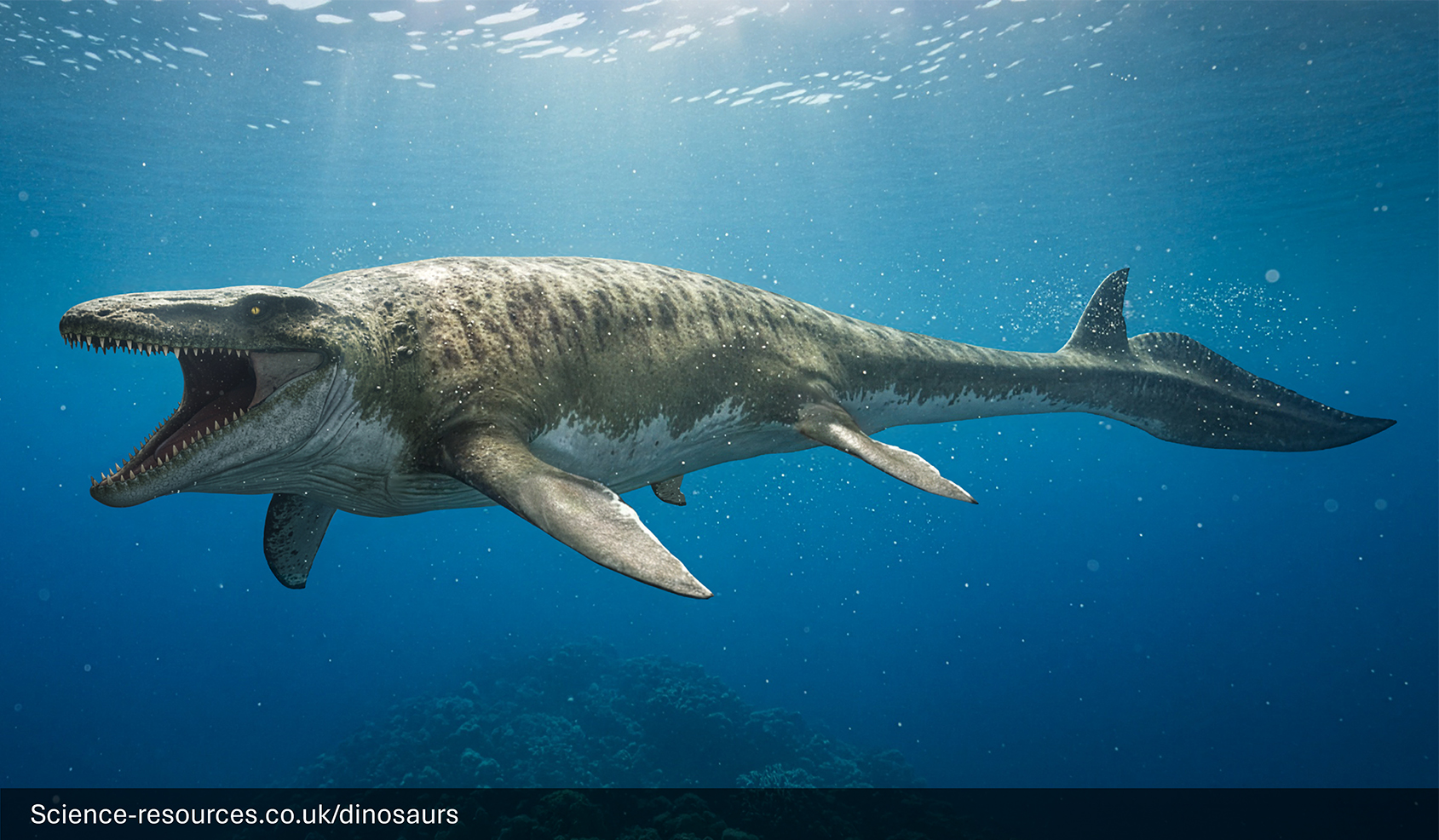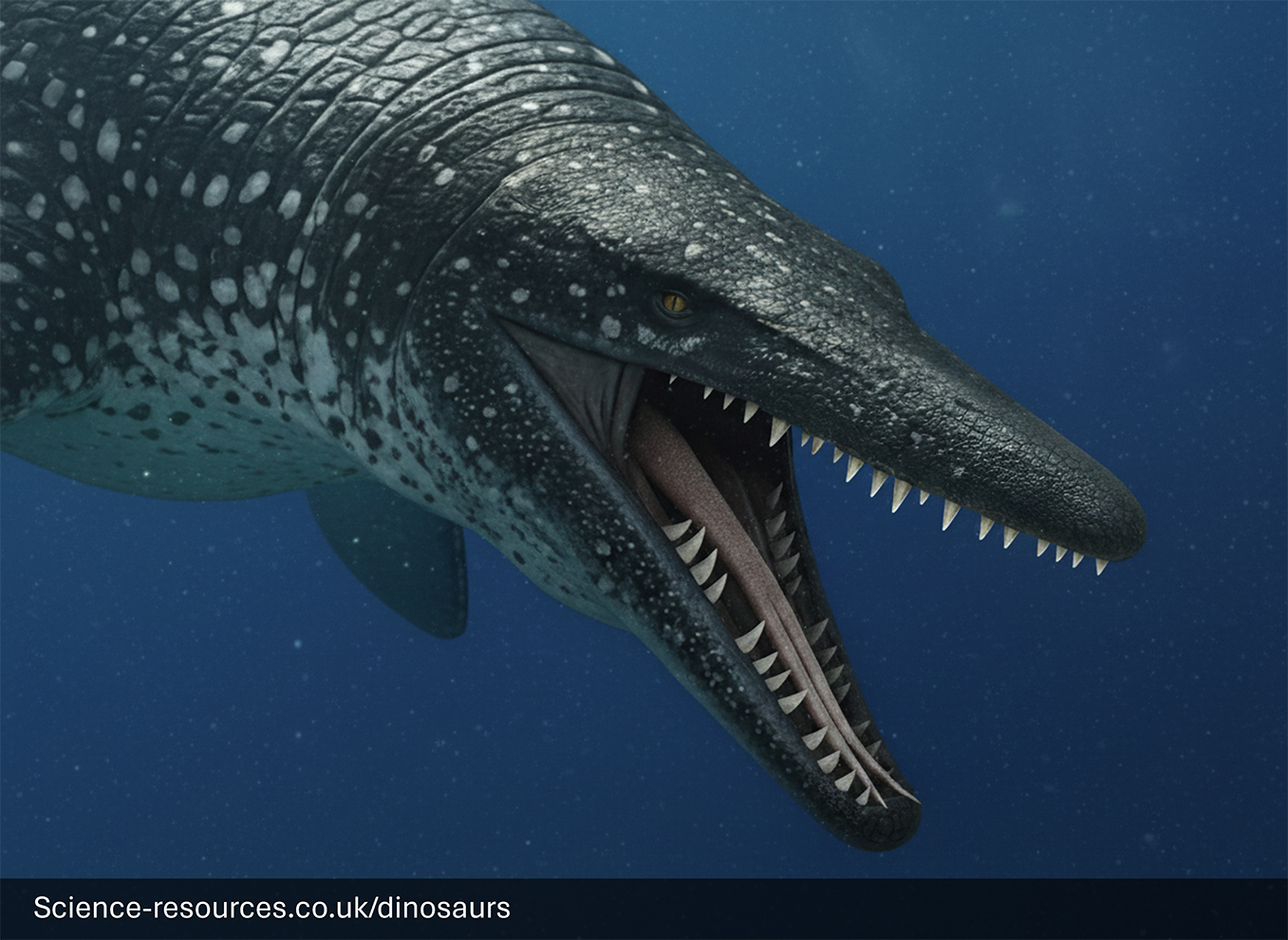Dinosaurs A:Z | M
You may also be intrested in: Free Dinosaur games
Dinosaurs and other prehistoric animals:
Mosasaurus (Meuse lizard)
You may also be intrested in: Free Dinosaur games
Last updated: 7th August 2025 Mosasaurus was an enormous aquatic lizard that lived during the late Cretaceous period. It was not a dinosaur, but a marine reptile that lived in the oceans. The name Mosasaurus means "Meuse lizard," named after the Meuse River where the first fossil was found. Mosasaurus lived during the Cretaceous period, which was around 145 to 66 million years ago. Fossils of Mosasaurus have been found in Europe and North America, including places like France, South Dakota, and Nebraska. Mosasaurus lived near the surface of the water, as it needed to breathe air, much like modern whales. It inhabited the North Atlantic Ocean, where it could easily hunt for food. Length: The largest species of Mosasaurus could grow to over 15 meters (50 feet) long. It had a streamlined body, a skull bristling with teeth, a barrel-like trunk, and a long, powerful tail. Mosasaurus had a streamlined skull with many sharp teeth, perfect for catching its prey. Its midsection was barrel-like, and it had a long tail for powerful swimming. It also had two sets of fins, one set at the front and one at the back, to help it steer through the water. Generative AI Notification: Some elements of this image have been created or enhanced using AI technology. To find out how we create all our dinosaurs, click here. Mosasaurus was a carnivore, meaning it ate meat. It likely fed on fish, plesiosaurs, and even other Mosasaurs, as well as any other edible animals it encountered in its habitat.
What is Mosasaurus?
When and where did Mosasaurus live?
How big was Mosasaurus?
Appearance
 Mosasaurus
MosasaurusWhat did Mosasaurus eat?
Interesting facts
Pronounced: mo-sa-SAW-rus


Name Means: "Meuse lizard"
Length: Up to 15 meters (50 feet)
Diet: Carnivore (Fish, other marine reptiles)
Time: Cretaceous - 145 to 66 million years ago
Habitat: Open Seas
Fossils Found: Europe, North America, South America.
The Mosasaurus featured in the Jurassic World and Jurassic World Rebirth films is an impressive sight, but how closely does it resemble the real-life marine reptile from the Cretaceous period?
How accurate is the Jurassic World Mosasaurus?
Size and body shape
Tail and propulsion
- Jurassic World: Uses its large flippers for propulsion, and the tail has a large, scaly fluke.
- Real life: Propulsion came from its tail fluke, which was a soft-tissue structure, and the flippers were used for stability.
Head and teeth
- Jurassic World: Features jagged, non-uniform teeth that are often exposed and a more "shrink-wrapped" appearance in later versions. It also has baleen whale-like throat grooves in the Rebirth version, which is inaccurate for a reptile.
- Real life: Had smooth teeth hidden by lips, similar to a monitor lizard. Its brain was also likely smaller and narrower.
Colour
- Jurassic World: Coloured in shades of blue and grey.
- Real life: Likely had a darker, counter shaded coloration (darker on top, lighter on the bottom).
Other differences
- Jurassic World: Exhibits acrobatic breaching behaviour.
- Real life: The full extent of its behavioural capabilities is not fully known, but its anatomy makes highly acrobatic breaches unlikely.
 Jurassic World Mosasaurus
Jurassic World Mosasaurus
 Jurassic World Rebirth Mosasaurus
Jurassic World Rebirth Mosasaurus
Jurassic World Mosasaurus size comparison
|
Left: Jurassic World Mosasaurus compared to an average-sized adult human
Right: Actual Mosasaurus size compared to an average-sized adult human
Did Mosasaurus have a forked tongue?
Yes, it is widely believed that mosasaurs had a forked tongue, similar to their modern relatives like snakes and monitor lizards. This is based on their shared anatomy, such as a paired openings in the palate for the vomeronasal organ (or Jacobson's organ), which they likely used to "taste" their environment for chemical traces.

Mosasaurus with a forked tongue
Which family of reptiles did Mosasaurus belong to?
Mosasaurus belonged to the marine reptiles and was a member of the larger group called mosasaurs.
How did Mosasaurus move?
Mosasaurus was an agile swimmer, moving through the water by undulating its body and using its powerful tail for propulsion. Its fins helped it steer and maintain balance as it navigated the ocean.
What Were the Unique Features of Mosasaurus?
Mosasaurus had a streamlined body, a long, powerful tail, and two sets of fins for steering. Its skull was filled with sharp teeth, which made it an effective hunter. Its large size and predatory nature made it one of the dominant marine reptiles of its time.
What other Dinosaurs / Prehistoric animals lived at the same time as Mosasaurus?
During the Cretaceous Period, which lasted for about 79 million years, Mosasaurus shared the planet with a multitude of other fascinating dinosaurs and prehistoric animals. Some of the notable contemporaries of Mosasaurus include:
- Tyrannosaurus Rex: One of the most famous dinosaurs, Tyrannosaurus Rex, was a massive carnivore with a powerful bite. It measured about 12 metres in length and was a top predator in its ecosystem.
- Triceratops: A large herbivorous dinosaur known for its three distinctive facial horns and large bony frill, Triceratops was a formidable presence in the Cretaceous landscape.
- Edmontosaurus: A duck-billed dinosaur, or hadrosaur, Edmontosaurus was a large, plant-eating dinosaur that traveled in herds and inhabited a wide range of environments.
- Velociraptor: Although smaller than its movie counterpart, Velociraptor was a swift, agile predator known for its intelligence and hunting prowess, likely preying on smaller animals.
- Ankylosaurus: A heavily armored herbivore, Ankylosaurus was covered in bony plates and wielded a powerful club-like tail to defend itself against predators.
- Pachycephalosaurus: Recognisable by its thick, domed skull, Pachycephalosaurus is believed to have used its head in combat, possibly in intraspecies rivalry.
- Quetzalcoatlus: One of the largest flying animals ever, this pterosaur had a wingspan comparable to a small aircraft and soared over the Cretaceous skies.
- Deinonychus: A close relative of Velociraptor, Deinonychus was a similarly agile and intelligent predator, noted for its sickle-shaped claw on each hind foot.
- Parasaurolophus: Another hadrosaur, Parasaurolophus was known for its long, curved cranial crest, which may have been used for communication or display.
- Spinosaurus: One of the largest carnivorous dinosaurs, Spinosaurus was semi-aquatic, with a distinctive sail-like structure on its back and a diet that included fish and other prey.
- Thyreophora: An armored dinosaur similar to Ankylosaurus, Thyreophora had rows of protective plates along its back and tail, providing defense against predators.
These diverse inhabitants of the Cretaceous Period contributed to a vibrant and complex ecosystem, each playing unique roles in their environment.
Mosasaurus FAQ
Q1: What is a Mosasaurus?
A1: Mosasaurus was a large, marine reptile that lived during the Late Cretaceous Period, around 82-66 million years ago. Its name means "Meuse lizard" because its first fossils were found near the Meuse River in Europe.
Q2: How big was the Mosasaurus?
A2: Mosasaurus could grow up to 56 feet long, making it one of the largest marine predators of its time. It had a long, streamlined body and powerful tail for swimming.
Q3: What did Mosasaurus eat?
A3: Mosasaurus was a carnivore, meaning it ate meat. It likely fed on fish, squid, and other marine reptiles, using its sharp teeth and strong jaws to catch and eat its prey.
Q4: Where did Mosasaurus live?
A4: Mosasaurus lived in the oceans that covered what is now Europe, North America, and Africa. Fossils have been found in these regions, indicating it had a wide distribution.
Q5: What makes Mosasaurus different from other marine reptiles?
A5: Mosasaurus is known for its large size, powerful jaws, and double-hinged jaw structure, which allowed it to swallow large prey whole. It also had paddle-like limbs for swimming.
Q6: How did Mosasaurus move?
A6: Mosasaurus used its powerful tail to propel itself through the water. Its paddle-like limbs helped it steer and maneuver while swimming.
Q7: What did Mosasaurus look like?
A7: Mosasaurus had a long, streamlined body, a large head with sharp teeth, and paddle-like limbs. It also had a powerful tail that helped it swim quickly through the water.
Q8: Why is Mosasaurus important to scientists?
A8: Mosasaurus provides valuable insights into the evolution of marine reptiles and their adaptations to life in the ocean. Its fossils help scientists understand the diversity of marine life during the Cretaceous.
Q9: Where can I see a Mosasaurus skeleton?
A9: You can see Mosasaurus skeletons in several museums, including the Natural History Museum in London and the National Museum of Natural History in Washington, D.C.
Q10: What is the significance of the name Mosasaurus?
A10: The name Mosasaurus means "Meuse lizard," reflecting its discovery near the Meuse River in Europe. It was named by paleontologist William Conybeare in 1822.
You may also be intrested in:
- How we create our dinosaurs
- How big were dinosaurs
- Dinosaurs: A-Z
Tags: How big was Mosasaurus, Mosasaurus size, where does Mosasaurus live, how long was Mosasaurus, what does Mosasaurus mean, Mosasaurus, Mosasaur, Mosasaurus facts
